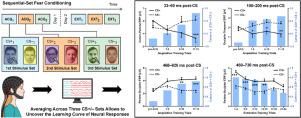当前位置:
X-MOL 学术
›
NeuroImage
›
论文详情
Our official English website, www.x-mol.net, welcomes your feedback! (Note: you will need to create a separate account there.)
Learning Dynamics of Electrophysiological Brain Signals During Human Fear Conditioning
NeuroImage ( IF 5.7 ) Pub Date : 2021-02-01 , DOI: 10.1016/j.neuroimage.2020.117569 Matthias F.J. Sperl , Adrian Wroblewski , Madeleine Mueller , Benjamin Straube , Erik M. Mueller
NeuroImage ( IF 5.7 ) Pub Date : 2021-02-01 , DOI: 10.1016/j.neuroimage.2020.117569 Matthias F.J. Sperl , Adrian Wroblewski , Madeleine Mueller , Benjamin Straube , Erik M. Mueller

|
Electrophysiological studies in rodents allow recording neural activity during threats with high temporal and spatial precision. Although fMRI has helped translate insights about the anatomy of underlying brain circuits to humans, the temporal dynamics of neural fear processes remain opaque and require EEG. To date, studies on electrophysiological brain signals in humans have helped to elucidate underlying perceptual and attentional processes, but have widely ignored how fear memory traces evolve over time. The low signal-to-noise ratio of EEG demands aggregations across high numbers of trials, which will wash out transient neurobiological processes that are induced by learning and prone to habituation. Here, our goal was to unravel the plasticity and temporal emergence of EEG responses during fear conditioning. To this end, we developed a new sequential-set fear conditioning paradigm that comprises three successive acquisition and extinction phases, each with a novel CS+/CS- set. Each set consists of two different neutral faces on different background colors which serve as CS+ and CS-, respectively. Thereby, this design provides sufficient trials for EEG analyses while tripling the relative amount of trials that tap into more transient neurobiological processes. Consistent with prior studies on ERP components, data-driven topographic EEG analyses revealed that ERP amplitudes were potentiated during time periods from 33-60 ms, 108-200 ms, and 468-820 ms indicating that fear conditioning prioritizes early sensory processing in the brain, but also facilitates neural responding during later attentional and evaluative stages. Importantly, averaging across the three CS+/- sets allowed us to probe the temporal evolution of neural processes: Responses during each of the three time windows gradually increased from early to late fear conditioning, while long-latency (460-730 ms) electrocortical responses diminished throughout fear extinction. Our novel paradigm demonstrates how short-, mid-, and long-latency EEG responses change during fear conditioning and extinction, findings that enlighten the learning curve of neurophysiological responses to threat in humans.
中文翻译:

人类恐惧条件下脑电生理信号的学习动态
啮齿动物的电生理学研究允许以高时间和空间精度记录威胁期间的神经活动。尽管 fMRI 有助于将有关潜在大脑回路解剖结构的见解转化为人类,但神经恐惧过程的时间动态仍然不透明,需要脑电图。迄今为止,对人类脑电生理信号的研究有助于阐明潜在的知觉和注意过程,但普遍忽略了恐惧记忆痕迹如何随时间演变。EEG 的低信噪比要求在大量试验中进行聚合,这将消除由学习引起并易于习惯化的短暂神经生物学过程。在这里,我们的目标是解开恐惧条件反射期间脑电图反应的可塑性和时间出现。为此,我们开发了一种新的顺序集恐惧条件反射范式,包括三个连续的获取和消退阶段,每个阶段都有一个新的 CS+/CS- 集。每组由两个不同背景颜色的不同中性面组成,分别用作 CS+ 和 CS-。因此,这种设计为 EEG 分析提供了足够的试验,同时将涉及更短暂神经生物学过程的试验的相对数量增加了三倍。与先前对 ERP 组件的研究一致,数据驱动的地形 EEG 分析显示 ERP 振幅在 33-60 毫秒、108-200 毫秒和 468-820 毫秒的时间段内增强,表明恐惧条件反射优先考虑大脑中的早期感觉处理,但也促进了后期注意和评估阶段的神经反应。重要的,三个 CS+/- 集的平均使我们能够探索神经过程的时间演变:三个时间窗口中的每个时间窗口的反应从恐惧条件的早期到晚期逐渐增加,而长延迟(460-730 毫秒)电皮质反应在整个过程中减弱害怕灭绝。我们的新范式展示了在恐惧条件反射和灭绝过程中短、中和长延迟 EEG 反应如何变化,这些发现启发了人类对威胁的神经生理学反应的学习曲线。
更新日期:2021-02-01
中文翻译:

人类恐惧条件下脑电生理信号的学习动态
啮齿动物的电生理学研究允许以高时间和空间精度记录威胁期间的神经活动。尽管 fMRI 有助于将有关潜在大脑回路解剖结构的见解转化为人类,但神经恐惧过程的时间动态仍然不透明,需要脑电图。迄今为止,对人类脑电生理信号的研究有助于阐明潜在的知觉和注意过程,但普遍忽略了恐惧记忆痕迹如何随时间演变。EEG 的低信噪比要求在大量试验中进行聚合,这将消除由学习引起并易于习惯化的短暂神经生物学过程。在这里,我们的目标是解开恐惧条件反射期间脑电图反应的可塑性和时间出现。为此,我们开发了一种新的顺序集恐惧条件反射范式,包括三个连续的获取和消退阶段,每个阶段都有一个新的 CS+/CS- 集。每组由两个不同背景颜色的不同中性面组成,分别用作 CS+ 和 CS-。因此,这种设计为 EEG 分析提供了足够的试验,同时将涉及更短暂神经生物学过程的试验的相对数量增加了三倍。与先前对 ERP 组件的研究一致,数据驱动的地形 EEG 分析显示 ERP 振幅在 33-60 毫秒、108-200 毫秒和 468-820 毫秒的时间段内增强,表明恐惧条件反射优先考虑大脑中的早期感觉处理,但也促进了后期注意和评估阶段的神经反应。重要的,三个 CS+/- 集的平均使我们能够探索神经过程的时间演变:三个时间窗口中的每个时间窗口的反应从恐惧条件的早期到晚期逐渐增加,而长延迟(460-730 毫秒)电皮质反应在整个过程中减弱害怕灭绝。我们的新范式展示了在恐惧条件反射和灭绝过程中短、中和长延迟 EEG 反应如何变化,这些发现启发了人类对威胁的神经生理学反应的学习曲线。

























 京公网安备 11010802027423号
京公网安备 11010802027423号